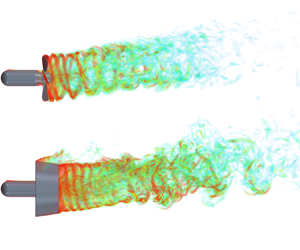Published online by Cambridge University Press: 16 March 2023

The effect of a nozzle on the wake dynamics of a four-bladed propeller operating in an oblique flow is investigated via modal decomposition and flow visualization of the results obtained from numerical simulations using delayed detached eddy simulations. The wake characteristics and destabilization mechanisms of a non-ducted propeller (NP) and ducted propeller (DP) in axisymmetric and oblique flow conditions are systematically analysed. The wake characteristics on the windward side are very different from those on the leeward side in an oblique flow, and the nozzle has a crucial role in mitigating the asymmetry and weakening the wake deflection. More destabilization mechanisms are present in an oblique flow than in an axisymmetric flow, including the asymmetric evolution and destabilization of the helixes on the windward and leeward sides of the NP wake, the interaction between the vortex shedding and the helixes in the DP leeward region, and the generation of a tube-shaped wake envelope around the nozzle and its rolling-up. Moreover, the effect of the nozzle on wake meandering is discussed based on modal analysis.